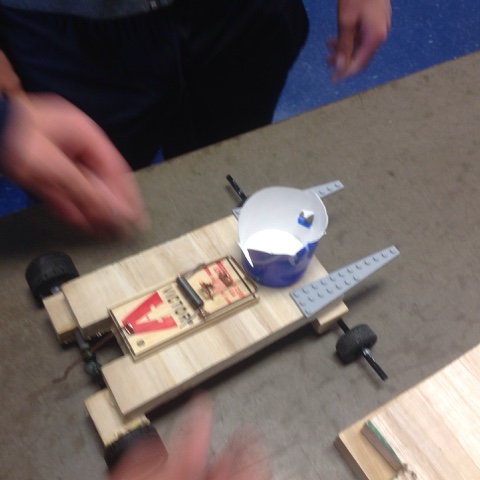Period 4
Physics
Mr. Yav
Vehicle name: Another Win
B) Table of Contents:
-Introduction
-Construction Procedure
-Operation of Mousetrap Car
-Results
-Conclusion/Improvements
-Appendix
C) The purpose of this project was to use a mousetrap and other materials to build a "car" that would demonstrate the conservation of energy as it's transferred from elastic PE to KE. We will also demonstrate the conservation of momentum through the aftermath of collisions. We must use other materials to protect an egg that will be placed on the car. Our goal is to use a mousetrap to power the car and move it towards a downward ramp that will be opposite of another car. The cars will collide and our goal is to break the opponents egg and keep ours safe. Our preliminary ideas included using lego tires in order to increase the traction, using a pencil in order to increase leverage, and using lego pieces as axels in order to increase durability. We also planned to keep the car light by not adding any extra materials.
F) A mousetrap car harnesses the spring potential energy of a mousetrap. When the handle of the mousetrap is pulled back, a large amount of potential energy is at play as the spring is being contained. When the handle is released, that potential energy is turned into kinetic energy. More specifically, when the handle is released it whips back into its original position, pulling the string with it, which in turn pulls the axel of the back wheels. This causes the wheels to turn, moving the car. For a short spurt of energy the length of the handle on the mousetrap will do fine, but for less velocity covering a greater distance, a longer rod will need to be attached to the handle to increase the tension in the string, making it harder for the spring to overcome and thus increasing the time it take to finish.
G) Our car outperformed any of our expectations because it wasn't even working just minutes before we had to joust. Our car didn't even make it down the ramp for our first round so we had to make adjustments and fight our way through the losers bracket to make it to the championship. We ended up losing in the championship round because the opposing car caused our egg to fly out and break. For the time trial, our time for 1.5 meters was 1.74 seconds. Using this information we can find the acceleration: a=d/t; a=1.5m/1.74 sec which leads to the acceleration being equal to .86 m/s^2.
H) In a way, we were incredibly lucky because our car's light structure made it prone to being impaled easily by opposing cars, but it also allowed for more speed. In another lucky turn of events, our car made it to the end of the runway but would often fall apart when it got to the end causing us to reassemble it. Through all these misfortunes, we learned that there were many improvements that we could have made ahead of time in order to avoid last minute car breakdowns that caused us much stress. First, our car's misbalanced structure caused us to have to add more mousetraps at the last minute to balance the car. We could have avoided this by testing out the car ahead of time and adding different weights onto the car that weren't bulky. We also used too much fishing line to spin the axel, unfortunately this would lead to our loss in competition because our car eventually got caught on the line and did not move. They were definitely things that we would keep if we did it again like the fact that we decided not to use a pencil to increase the motion of the vehicle. Also, we would keep the light design of the vehicle and the lego tires and axel.
I)










No comments:
Post a Comment